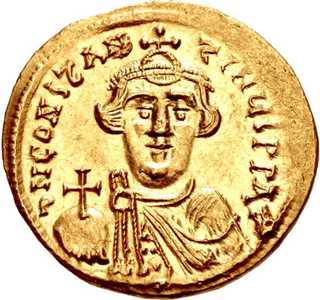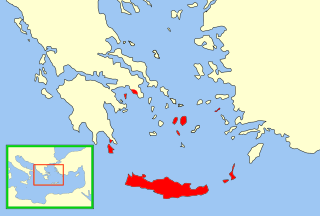Related Research Articles
The 700s decade ran from January 1, 700, to December 31, 709.
The 660s decade ran from January 1, 660, to December 31, 669.

Year 811 (DCCCXI) was a common year starting on Wednesday of the Julian calendar.

Year 806 (DCCCVI) was a common year starting on Thursday of the Julian calendar.

Heraclius, known by the diminutive Heraclonas or Heracleonas, and more rarely as Heraclius II, was the son of Heraclius and his niece Martina. His father had stipulated in his will that both of his sons, Heraclonas and Constantine III, should rule jointly upon his death. Heraclius also specified that his wife, Martina, was to be called "Mother and Empress" insofar as she might have influence at court as well. The emperor Heraclius died in February 641 from edema. When Martina did make the late Emperor's will public she faced staunch resistance to her playing any active role in government, but both Heraclonas and Constantine were proclaimed joint-emperors in February 641 without incident. After Constantine died of tuberculosis in April/May 641, Heraclonas became sole emperor, under the regency of his mother due to his young age. He reigned from April/May – October/November 641, when he was overthrown by Valentinus, a general and usurper of Armenian extract, who installed Constans II, the son of Constantine III. Valentinus had Heraclonas' nose cut off, then exiled him to Rhodes, where he is believed to have died in the following year.

Constans II, nicknamed "the Bearded", was the Eastern Roman emperor from 641 to 668. Constans was the last attested emperor to serve as consul, in 642, although the office continued to exist until the reign of Leo VI the Wise.

The Byzantine Empire was ruled by emperors of the dynasty of Heraclius between 610 and 711. The Heraclians presided over a period of cataclysmic events that were a watershed in the history of the Empire and the world.
Fausta was the Byzantine empress as the wife of Constans II.
Gregory the Patrician was a Byzantine Exarch of Africa. A relative of the ruling Heraclian dynasty, Gregory was fiercely pro-Chalcedonian and led a rebellion in 646 against Emperor Constans II over the latter's support for Monothelism. Soon after declaring himself emperor, he faced an Arab invasion in 647. He confronted the invaders but was decisively defeated and killed at Sufetula. Africa returned to imperial allegiance after his death and the Arabs' withdrawal, but the foundations of Byzantine rule there had been fatally undermined.
The Byzantine civil war of 1373–1379 was a military conflict fought in the Byzantine Empire between Byzantine Emperor John V Palaiologos and his son, Andronikos IV Palaiologos, also growing into an Ottoman civil war as well, when Savcı Bey, the son of Ottoman Emperor Murad I joined Andronikos in a joint rebellion against their fathers. It began when Andronikos sought to overthrow his father in 1373. Although he failed, with Genoese aid, Andronikos was eventually able to overthrow and imprison John V in 1376. In 1379 however, John V escaped, and with Ottoman help, regained his throne. The civil war further weakened the declining Byzantine Empire, which had already suffered several devastating civil wars earlier in the century. The major beneficiary of the war were the Ottomans, whose vassals the Byzantines had effectively become.

The Emirate of Crete was an Islamic state that existed on the Mediterranean island of Crete from the late 820s to the reconquest of the island by the Byzantine Empire in 961. Although the emirate recognized the suzerainty of the Abbasid Caliphate and maintained close ties with Tulunid Egypt, it was de facto independent.
The Karabisianoi, sometimes anglicized as the Carabisians, were the main forces of the Byzantine navy from the mid-7th century until the early 8th century. The name derives from the Greek karabos or karabis for "ship", and literally means "people of the ships, sea-men". The Karabisianoi were the first new permanent naval establishment of the Byzantine Empire, formed to confront the Muslim expansion at sea. They were disbanded and replaced with a series of maritime themes some time in 718–730.
The Typos of Constans was an edict issued by eastern Roman emperor Constans II in 648 in an attempt to defuse the confusion and arguments over the Christological doctrine of Monotheletism. For over two centuries, there had been a bitter debate regarding the nature of Christ: the orthodox Chalcedonian position defined Christ as having two natures in one person, whereas Miaphysite opponents contended that Jesus Christ possessed but a single nature. At the time, the Byzantine Empire had been at near constant war for fifty years and had lost large territories. It was under great pressure to establish domestic unity. This was hampered by the large number of Byzantines who rejected the Council of Chalcedon in favour of Monophysitism.
Saborios or Saborius was a Byzantine general who rose in revolt against Emperor Constans II in 667–668. He sought and obtained the aid of the Caliph Muawiyah I, but was killed in a horse accident before confronting the imperial troops.
Domentziolus or Domnitziolus was a nephew of the Byzantine emperor Phocas, appointed curopalates and general in the East during his uncle's reign. He was one of the senior Byzantine military leaders during the opening stages of the Byzantine–Sassanid War of 602–628. His defeats opened the way for the fall of Mesopotamia and Armenia and the invasion of Anatolia by the Persians. In 610, Phocas was overthrown by Heraclius, and Domentziolus was captured but escaped serious harm.
Staurakios was a Byzantine Greek eunuch official, who rose to be one of the most important and influential associates of Byzantine empress Irene of Athens. He effectively acted as chief minister during her regency for her young son, Emperor Constantine VI in 780–790, until overthrown and exiled by a military revolt in favour of the young emperor in 790. Restored to power by Constantine along with Irene in 792, Staurakios aided her in the eventual removal, blinding, and possible murder of her son in 797. His own position thereafter was threatened by the rise of another powerful eunuch, Aetios. Their increasing rivalry, and Staurakios's own imperial ambitions, were only resolved by Staurakios's death.
Gennadius, sometimes referred to as Gennadius II, was a Byzantine general who exercised the role of Exarch of Africa from 648 to 665. In 664 Gennadius rebelled against Emperor Constans II and was himself overthrown the next year by a loyalist uprising.
The Battle of Sufetula took place in 647 between the Arab Muslim forces of the Rashidun Caliphate and the Byzantine Exarchate of Africa.
Martinus or Marinus was caesar of the Byzantine Empire from c. 638–September/October 641. Martinus was the son of Emperor Heraclius and Empress Martina. Under Heraclius, Martinus was elevated to caesar in c. 638. Heraclius left the Byzantine Empire to two of Martinus' brothers, Constantine III and Heraklonas; Constantine soon died of tuberculosis, though some of his partisans alleged that he was poisoned by Martina. One such partisan, Valentinus, led troops to Chalcedon to force Martina to make Constans II, the son of Constantine, co-emperor. Valentinus seized Constantinople regardless in September/October 641, and deposed Martina, Heraklonas, and Martinus, and cut off Martinus' nose and emasculated him, before exiling him to Rhodes.
References
- ↑ Treadgold 1995 , p. 21
- ↑ Treadgold 1997 , p. 935.
- ↑ Pringle 1981 , p. 47.
- ↑ Treadgold 1997 , p. 320.